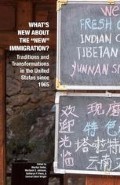Abstract
On October 3, 1965, President Lyndon B. Johnson traveled to New York Harbor, where, in the shadow of the Statue of Liberty, he signed the Immigration and Nationality Act of 1965. Johnson assured his audience that the new law was “not a revolutionary bill. It does not affect the lives of millions. It will not reshape the structure of our daily lives, or really add importantly to either our wealth or our power.”1 The half century since its passage has proven Lyndon Johnson’s prediction wrong. Contrary to his forecast, the 1965 act stands as the foundation of recent immigration policy, and its passage marks a crucial turning point in US history more broadly. What’s New about the “New” Immigration? brings together a diverse range of scholars to investigate the central role of migration in recent American history, from cities to suburbs, in mosques and churches, at border checkpoints and in the voting booth.
Access this chapter
Tax calculation will be finalised at checkout
Purchases are for personal use only
Preview
Unable to display preview. Download preview PDF.
Notes
Lyndon B. Johnson, “Remarks at the Signing of the Immigration Bill, Liberty Island, New York,” October 3, 1965, in Public Papers of the Presidents of the United States: Lyndon B. Johnson, 1965 (Washington, DC: Government Printing Office, 1966), 1038.
See, for example, Herbert Gans, “Symbolic Ethnicity: The Future of Ethnic Groups and Cultures in America,” Ethnic and Racial Studies 2, no. 1 (1979): 1–20
Mary Waters, Ethnic Options: Choosing Identities in America (Berkeley: University of California Press, 1990)
Richard Alba, Ethnic Identity: The Transformation of White America (New Haven, CT: Yale University Press, 1990).
Blas Nuñez-Neto, Border Security: The Role of the U.S. Border Patrol (Washington, DC: Congressional Research Service, 2008); United States Customs and Border Protection, Border Patrol Overview, http://www.cbp.gov/ border-security/along-us-borders/overview, accessed September 23, 2014.
Jeanne Batalova, Senior Immigrants in the United States, Migration Information Source, May 2012, http://www.migrationpolicy.org/article/senior-immigrants-united-states, accessed September 23, 2014.
Jeanne Batalova and Alicia Lee, Frequently Requested Statistics on Immigrants and Immigration in the United States, Migration Information Source, March 2012, http://www.migrationpolicy.org/article/frequently-requested-statistics-immigrants-and-immigration-united-states-0, accessed September 23, 2014.
William H. Frey, Alan Berube, Audrey Singer, and Jill H. Wilson, Getting Current: Recent Demographic Trends in Metropolitan America (Washington, DC: Brookings Metropolitan Policy Program, March 2009), 10, http://www.brookings.edu/~/media/Files/rc/reports/2009/03_metro_demographic_ trends/03_metro_demographic_trends.pdf.
Matthew Hall, Audrey Singer, Gordon F. De Jong, and Deborah Roempke Graefe, The Geography of Immigrant Skills: Educational Profiles of Metropolitan America (Washington, DC: Brookings Metropolitan Policy Program, June 9, 2011), http://www.brookings.edu/papers/2011/06_immigrants_singer.aspx.
Timothy Fong, The First Suburban Chinatown: The Remaking of Monterey Park, California (Philadelphia, PA: Temple University Press, 1994).
Mae M. Ngai, Impossible Subjects: Illegal Aliens and the Making of Modern America (Princeton, NJ: Princeton University Press, 2004)
Alicia Schmidt Camacho, Migrant Imaginaries: Latino Cultural Politics in the U.S.-Mexico Borderlands (New York: New York University Press, 2008).
John R. Logan and Charles Zhang, “Global Neighborhoods: New Pathways to Diversity and Separation,” American Journal of Sociology 115 (January 2010): 1069–1109.
Karen R. Humes, Nicholas A. Jones, and Roberto R. Ramirez, Overview of Race and Hispanic Origin: 2010 (Washington, DC: US Census Bureau, March 2011), http://www.census.gov/prod/cen2010/brief/c2010br-02.pdf.
United States Bureau of Labor Statistics, Union Members Summary, http://www.bls.gov/news.release/union2.nr0.htm, accessed September 23, 2014.
Editor information
Copyright information
© 2014 Massachusetts Historical Society
About this chapter
Cite this chapter
Halter, M., Capozzola, C. (2014). Introduction. In: Halter, M., Johnson, M.S., Viens, K.P., Wright, C.E. (eds) What’s New about the “New” Immigration?. Palgrave Macmillan, New York. https://doi.org/10.1057/9781137483850_1
Download citation
DOI: https://doi.org/10.1057/9781137483850_1
Publisher Name: Palgrave Macmillan, New York
Print ISBN: 978-1-349-50325-4
Online ISBN: 978-1-137-48385-0
eBook Packages: Palgrave History CollectionHistory (R0)

